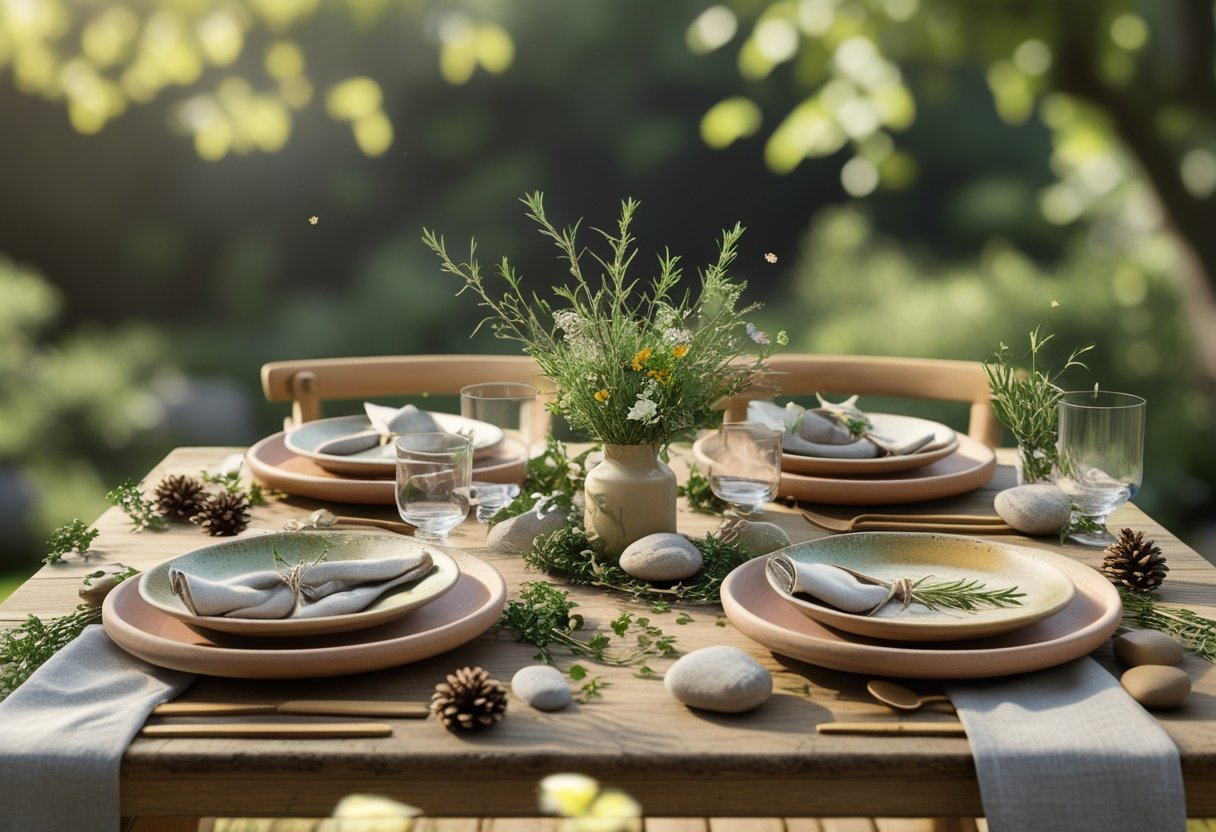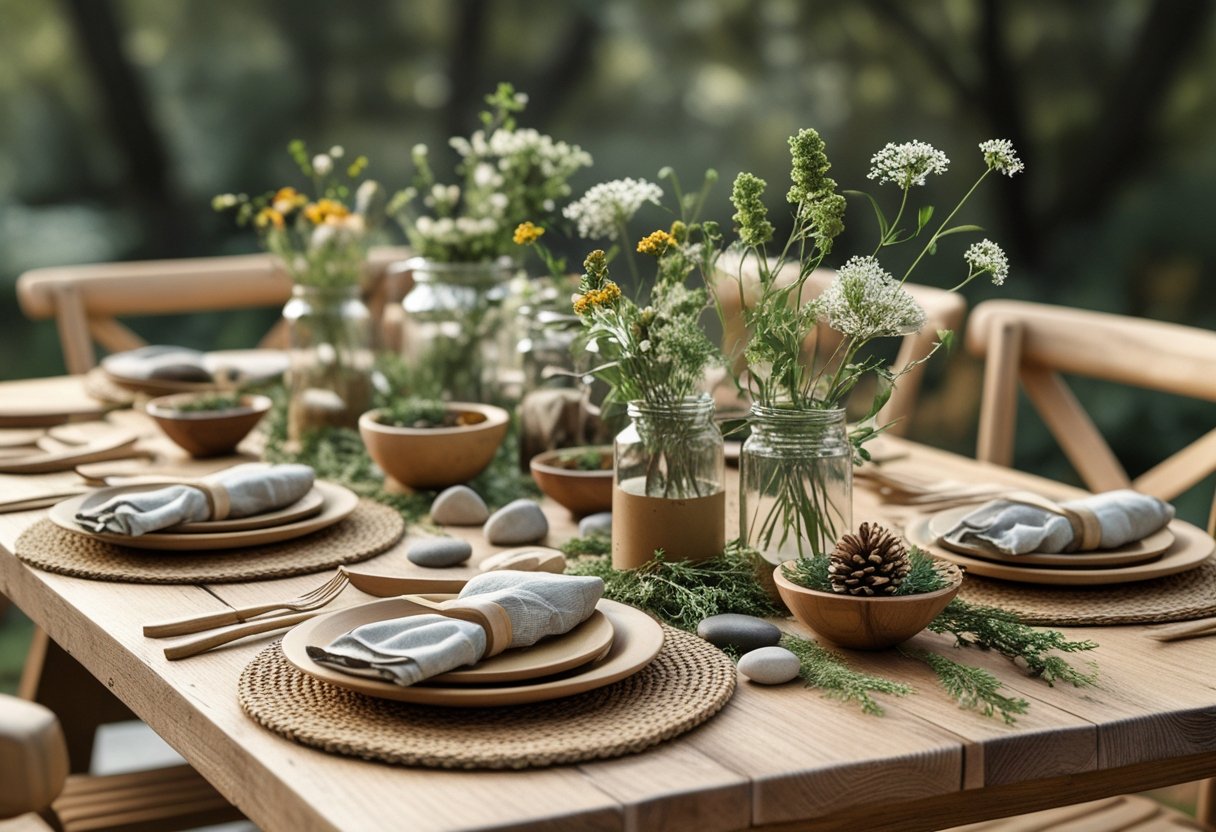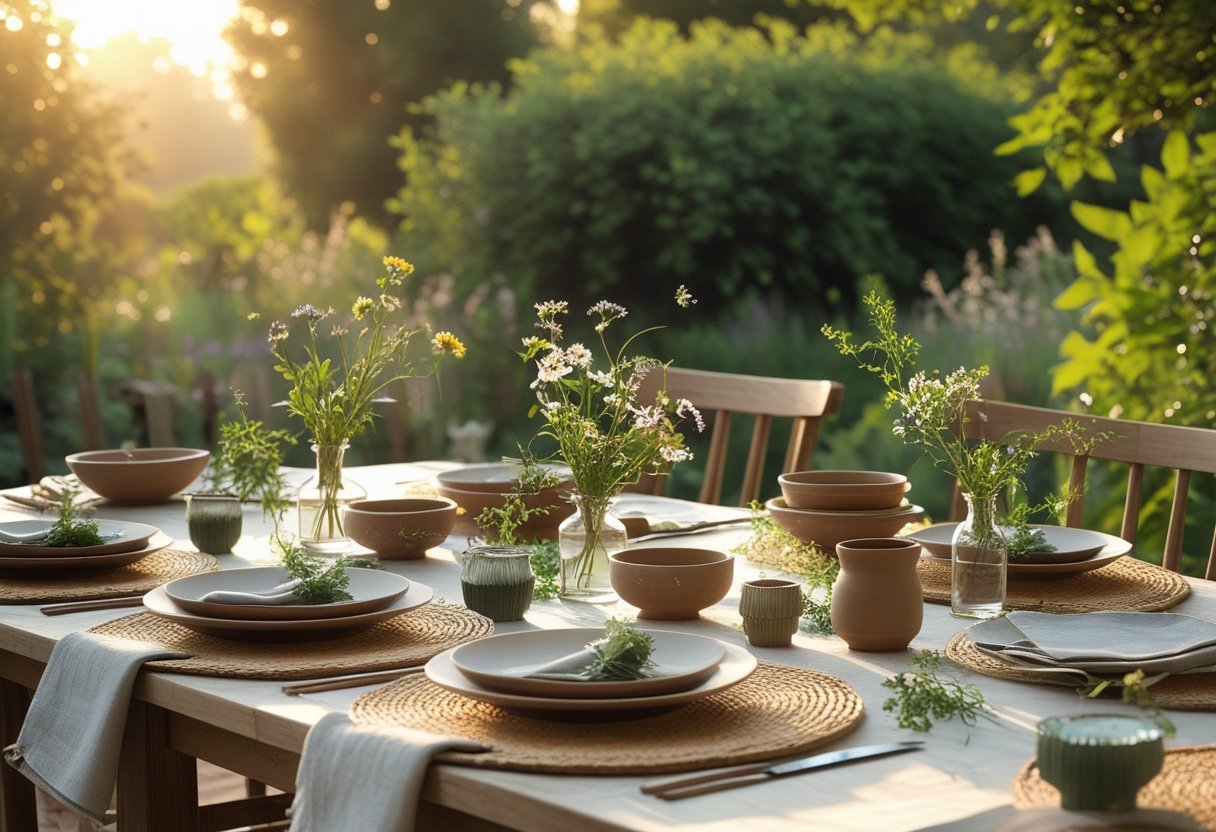Creating beautiful table settings doesn’t require expensive decorations or formal training. Natural elements like leaves, pine cones, wood, and fresh flowers can transform any dining space into something special. These simple materials are often free and easy to find, making them perfect for anyone who wants to impress their guests without breaking the budget.

The key to successful natural table settings is using everyday materials from nature to create warm and inviting spaces that make guests feel comfortable and welcomed. Fun natural table settings work because they feel relaxed and authentic rather than stuffy or overdone. People connect with natural textures and colors because they remind us of the outdoors and create a calm atmosphere.
Many hosts worry that natural table settings might look too casual or unfinished. The truth is that nature-inspired designs can be just as elegant as formal place settings when done thoughtfully. The goal is to let natural beauty shine through simple arrangements that highlight the food and conversation rather than overwhelming the table with too many decorations.
Key Takeaways
- Natural table settings use simple materials like leaves, wood, and stones to create beautiful dining spaces without expensive decorations
- The best natural tables focus on the food and guests rather than overwhelming decorative elements
- Simple touches like wooden accents and seasonal elements can make any meal feel special and welcoming
Essentials of Fun Natural Table Settings

Creating beautiful natural table settings requires choosing eco-friendly materials, selecting fresh centerpiece elements from outdoors, and picking colors that match the seasons and natural world.
Choosing Organic and Sustainable Materials
Sustainable table linens and decor form the foundation of any eco-friendly dining setup. Organic cotton napkins, linen tablecloths, and hemp placemats provide texture while supporting environmental goals.
Natural Material Options:
- Bamboo plates and utensils
- Cork coasters and trivets
- Jute table runners
- Reclaimed wood charger plates
- Stone or ceramic serving dishes
Biodegradable cutlery and reusable ceramic dishes replace plastic items without sacrificing style. These materials break down naturally or last for many years of use.
Twine, burlap, and natural rope work well as napkin rings or decorative accents. They cost little but add rustic charm to place settings.
Incorporating Natural Centerpieces
Making food the centerpiece creates focus without overwhelming guests with tall decorations. Fresh fruits, vegetables, and herbs arranged on wooden boards or stone platters work perfectly.
Seasonal Centerpiece Ideas:
- Spring: Fresh flowers in mason jars, potted herbs
- Summer: Citrus fruits, seashells, driftwood
- Fall: Pumpkins, pinecones, colorful leaves
- Winter: Evergreen branches, berries, birch logs
Everyday materials like leaves, pine cones, and beeswax candles cost nothing when gathered from yards or parks. These items change with seasons and create unique looks for each gathering.
Small potted plants serve as both centerpieces and take-home gifts. Succulents, herbs, or small flowering plants work well for this purpose.
Harmonizing Colors with Nature
Natural, minimal, and neutral colors with tiny splashes of color create the most appealing natural table settings. Earth tones like browns, greens, and creams provide calm backgrounds for brighter accents.
Color Combinations That Work:
- Sage green with cream and gold accents
- Sandy beige with ocean blue touches
- Warm browns with orange and red highlights
- Soft grays with lavender or mint details
Soft linens in shades of blue and sandy beige work especially well for coastal or summer themes. These colors remind people of beaches and calm waters.
The colors of seasonal foods should guide decoration choices. Orange pumpkins pair with deep reds and golden yellows in fall. Fresh green salads look best with light, bright accent colors in spring and summer.
Creative Ideas for Table Decor
Natural table decor works best when you combine items from different seasons, add meaningful personal items, and mix smooth and rough textures. These three approaches help create tables that feel both beautiful and welcoming.
Using Seasonal Elements
Fall brings some of the best natural decorating materials. Pine cones, twigs, and dried leaves create warm autumn displays without spending money. Small pumpkins work as both decoration and place card holders.
Winter calls for evergreen branches and white candles. Fresh rosemary sprigs smell good and look elegant next to each plate. White pine cones painted with white paint add a snowy touch.
Spring tables shine with fresh flowers and green branches. Pussy willows in tall vases make simple centerpieces. Small potted herbs like basil or mint serve as take-home gifts for guests.
Summer Elements to Try:
- Fresh fruit as centerpieces
- Seashells and driftwood
- Wildflowers in mason jars
- Fresh mint leaves scattered on tables
Adding Personal Touches
Family photos in wooden frames make tables feel more personal. Old books stacked under small plants add height and show personality. Handwritten place cards on kraft paper feel more special than printed ones.
Collections work well as table decor. Vintage bottles hold single flowers. Old wooden spoons can display small plants or herbs. Even smooth rocks from family trips become conversation starters.
Children’s artwork can become place mats when laminated. Family recipes written on cards make unique napkin rings. These touches help guests feel more connected to the host.
Mixing Textures for Visual Appeal
Rough burlap table runners pair well with smooth wooden chargers. The contrast makes both materials look more interesting. Soft fabric napkins balance hard wooden serving bowls.
Woven placemats add texture under smooth white plates. Natural wood placemats work well with ceramic dishes. Metal serving pieces shine next to matte pottery.
Texture Combinations That Work:
- Smooth river rocks with fuzzy lamb’s ear leaves
- Rough tree bark under glass votive holders
- Soft moss around hard ceramic bowls
- Shiny copper mugs on woven grass mats
Layer different heights to create visual interest. Tall candlesticks next to low flower arrangements keep eyes moving around the table.
Practical Tips for Setting a Relaxed Atmosphere

Creating a comfortable dining space requires thoughtful placement of everyday items and simple natural touches. The right mix of functional pieces and earthy elements helps guests feel welcome without formal pressure.
Arranging Functional Tableware
Start with mismatched plates and bowls in neutral colors like cream, beige, or soft gray. These create visual interest without looking too formal. Mix ceramic pieces with different textures and sizes.
Place silverware casually beside each plate. Skip the formal placement rules. Forks can go on either side, and knives don’t need to point in specific directions.
Use cloth napkins in natural fabrics like linen or cotton. Earth tones work best – think sage green, warm brown, or dusty blue. Fold them simply or roll them loosely.
Set out serving dishes before guests arrive. Wooden bowls, ceramic platters, and glass dishes in various sizes make food sharing easy. Layer vibrant textiles, such as patterned table runners to add warmth without formality.
Keep glassware simple. Mason jars, mismatched vintage glasses, or clear tumblers work well. Avoid crystal or delicate pieces that make people nervous.
Enhancing Comfort with Natural Accents
Add fresh greenery from your yard or local park. Small branches, leaves, or herb sprigs scattered down the center create instant nature vibes. No fancy arrangements needed.
Use natural elements like leaves, pine cones, twine, wood, and beeswax candles for decoration. These items cost little and feel authentic.
Candles provide soft lighting that makes everyone look good. Use different heights and sizes in natural materials like beeswax or soy. Avoid scented candles during meals.
Place small potted plants or succulents around the table. Guests can take these home as simple gifts. Terra cotta pots or mason jars work as containers.
Consider your dining location and time of day. Make your table appropriate for the setting and time of day. Outdoor evening meals need more lighting than daytime brunches.
Keep textures interesting by mixing smooth and rough surfaces. Combine polished wood with woven placemats or smooth stones with rough bark pieces.
Inspiration from Real-Life Settings
Real outdoor parties and eco-friendly events show how natural table settings work in practice. These examples prove that simple materials like pinecones and branches create beautiful dining spaces.
Showcasing Outdoor Gatherings
Outdoor dining spaces benefit from natural decorating that flows from season to season. Hosts can use items they find nearby to create memorable table settings.
Popular outdoor table elements include:
- Fresh greenery and branches
- Pinecones and acorns
- Seasonal berries
- Small pumpkins or gourds
- Wheat stalks
Garden parties work well with wooden serving boards and mason jar water glasses. The natural setting provides a backdrop that complements simple decorations.
Picnic tables look great with burlap runners and wildflower centerpieces. Guests enjoy the relaxed feel of eating outdoors with natural materials around them.
Evening gatherings need soft lighting from battery-powered lanterns or solar lights. These create a warm glow without open flames that might be dangerous outdoors.
Highlighting Eco-Friendly Events
Eco-friendly table settings use recycled and natural materials to create sustainable dining experiences. These events show how beautiful tables can help the planet too.
Sustainable table setting options:
- Biodegradable plates and cups
- Cloth napkins instead of paper
- Reusable ceramic dishes
- Bamboo or wooden utensils
- Compostable decorations
Zero-waste events use items that can be composted or reused after the party. Dried flowers make pretty centerpieces that guests can take home to enjoy later.
Local farmers markets provide seasonal produce for both food and decoration. Apples, pears, and seasonal vegetables create colorful displays that people can eat.
Potted herbs serve as both decoration and party favors. Guests take home small plants like basil or rosemary to grow in their own gardens.
Frequently Asked Questions
Natural table settings offer endless possibilities for creating memorable dining experiences through simple materials and creative arrangements. These common questions address practical ways to use organic elements, DIY approaches, and seasonal decorating techniques.
How can you incorporate natural elements into party table settings for a lighthearted ambiance?
Pine cones, leaves, and twine create instant party charm without expensive decorations. Natural table settings using everyday materials bring warmth and personality to any celebration.
Wooden serving boards replace traditional platters for a rustic feel. Small potted herbs double as decorations and take-home gifts for guests.
Fresh fruit arrangements work as both centerpieces and snacks. Citrus slices, apple wedges, and berry clusters add color while staying functional.
Mason jars filled with wildflowers create casual focal points. Tie them with burlap ribbon or twine for extra texture.
What are some creative DIY natural table setting ideas for a dining experience?
DIY table settings with nature-inspired designs transform ordinary meals into special occasions. Handmade place cards using pressed leaves or small stones add personal touches.
Tree slices serve as unique charger plates under regular dishes. Sand them smooth and apply food-safe finish for repeated use.
Collect smooth river rocks to use as napkin weights. Paint guest names on them with white markers for personalized place settings.
Create napkin rings from flexible branches or grapevines. Twist them into circles and tuck in small flowers or herbs.
In what ways can a wedding table be decorated with natural materials to create a fun and elegant look?
Eucalyptus garlands running down table centers provide elegant greenery. Layer different textures like lamb’s ear or dusty miller for visual interest.
Wooden candle holders in varying heights create romantic lighting. Mix them with glass votives filled with sand or pebbles.
Burlap table runners soften formal linens while adding texture. Layer lace over burlap for a more refined appearance.
Small potted succulents at each place setting serve as favors. Guests can take them home to remember the celebration.
What are some unique natural centerpiece ideas that can enhance a table setting?
Hollow log sections filled with seasonal flowers create striking focal points. Drill drainage holes if using fresh arrangements.
Large glass bowls filled with layered sand, shells, and driftwood bring beach vibes indoors. Add battery-operated string lights for evening glow.
Antler or branch arrangements hold hanging glass orbs with tea lights. Secure them safely to prevent tipping or fire hazards.
Moss-covered spheres in different sizes cluster beautifully together. Mix in a few white or metallic ones for contrast.
How can natural elements be integrated into table settings for festive occasions like Christmas?
Fresh evergreen sprigs tucked into napkin folds release pleasant scents. Choose from pine, fir, or cedar based on local availability.
Pinecones painted with gold or silver tips add festive sparkle. Hot glue them to place card holders or scatter along the table.
Cinnamon stick bundles tied with red ribbon serve as aromatic decorations. Place one at each setting or use in centerpieces.
Cranberries and holly berries provide natural red accents. Float cranberries in water-filled glass bowls for simple elegance.
What are some neutral table setting ideas that create an interesting and inviting atmosphere?
Linen napkins in cream or beige tones provide softness without competing colors. Natural table settings focus on relaxed and beautiful dining experiences.
Wheat stalks or dried grass bundles add height and movement. Tie them with neutral ribbons that match your color scheme.
Natural jute placemats protect surfaces while adding texture. Layer them under white or cream dinner plates for contrast.
Unscented beeswax candles in ivory or natural tones provide warm lighting. Their subtle honey color complements most neutral palettes.
